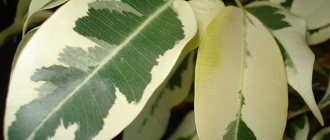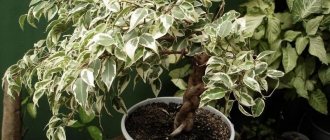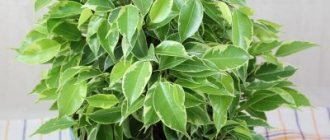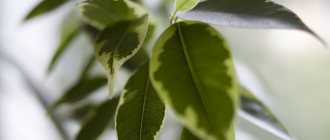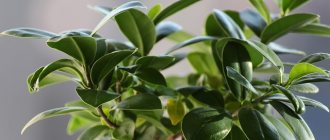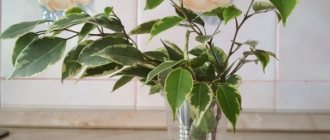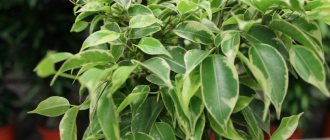The ever-popular houseplants, ficus trees, belong to the fig genus. Hundreds of species of ficus are native to the tropics, including Asia, America and Africa. These are ornamental, food and even religious plants; in Thailand they are a symbol of happiness and good luck. Some species of ficus are also known as fig trees and produce well-known fruits.
- Why is Ficus Benjamin so popular?
- Ficus benjamina plant varieties
- How to grow ficus benjamina Lighting for ficus benjamina
- Soil for ficus benjamina
- Rules for watering Ficus Benjamin
- Temperature and humidity for ficus benjamina
- Fertilizers for Ficus Benjamin
- Planting and replanting Ficus Benjamin
- Reproduction of Ficus Benjamin
- Pruning ficus benjamina
Why is Ficus Benjamin so popular?
Ficus benjamina, or weeping fig (Ficus benjamina), tropical laurel, Java fig, Java tree - a small-leaved rubber plant in its homeland, has curved stems with shiny green or variegated, variegated leaves. At home, some varieties grow into a small elegant tree, reaching 1.5 - 2.0 m in height.
Although ficus plants have special growing requirements, few plants are as adaptable to apartment conditions. And the favorite among growers is Ficus Benjamin, since the plant is excellent for beginners in bonsai culture; its shoots can be braided, and by cutting and grafting they can be given a spherical and standard shape.
Ficus benjamina
Ficus benjamina plant varieties
In nature, Ficus benjamina has narrow, glossy green leaves. Decorative species include the variegated ficus Bendazhmina (F. benjamina variegata) - it has rather pale green leaves with creamy white edges.
Varieties differ mainly in size, shape, color and variegation of leaves.
Ficus benjamina Anastasia
Anastasia - variegated leaf color with a wide light green uneven edge and a central vein of the same shade, the edges of the leaves are uneven. Variegation does not disappear with age.
Ficus benjamina Barok
Barok - Glossy green leaves curl around an arched vein. They grow from 3 cm to 4 cm in length, and up to 2 cm in width. For a more spectacular spectacle, Ficus Barok is recommended to plant several plants in one pot.
Ficus benjamina wiandi
Wiandi is a small plant with thin branches and medium-sized leaves, easily grown in bonsai culture. A distinctive feature of this variety is the trunk rotated 90 degrees.
Ficus benjamina Kinky
Kinky is a very compact ficus, no more than 40 cm high. The leaves are narrow, with multi-colored edges of green and cream.
Natasja - ficus Natasha is a miniature tree that has gained wide popularity thanks to the ability to braid its branches (for this, several plants are planted together). The leaves are slightly elongated, monochromatic.
Ficus benjamina Danielle
Danielle - this variety can reach a height of up to 2 meters. Dense, shiny foliage, light to dark green.
Variety of leaf colors of ficus benjamina varieties
De Gantel - the foliage color is predominantly white, with very wide variegation. The variety needs to be handled with care - it burns strongly in bright sun, and suffers from a lack of chlorophyll in the absence of lighting.
Ficus benjamina Golden King
Golden King - the leaves are long, about 7 cm, have slightly wavy edges and lemon-green variegation.
Ficus benjamina Starlight
Starlight - leaves with wide white variegation, growth is moderate.
Ficus benjamina Twilight
Twilight - variegated border is narrow, irregular in shape and can have different widths. The center of the leaf blade is green.
Description of the plant
Ficus Benjamina came to us from the tropical rainforests of Southeast Asia. It is named after the British botanist who specialized in seed plants, Benjamin Daydon Jackson. It grows in India, Southern China, the Philippines, Malaysia and Northern Australia. This is an evergreen representative of the Mulberry family. In a warm, humid environment, the tree can grow up to 30 meters in height, overgrown with branched shoots.
The trunk of the plant is gray-brown with rare brown streaks. Young erect shoots quickly become lignified. There are almost no aerial roots. The branches are drooping, forming a dense spreading crown. The leaves of Ficus Benjamin are thin, leathery, lanceolate in shape, with entire outer margins. Their length in large varieties reaches 13 cm, and their width up to 6 cm. In small-leaved varieties, the dimensions are much more modest. The central vein of light green color is clearly visible. The leaves are glossy. Different varieties have their own color - from light green to dark, with white, cream and yellow spots. Many varieties have edging on the leaves. The tip of each leaf is drawn into a drip point, characteristic of this type of ficus. Excess water flows down it and falls on the leaves.
Ficus leaves are located on the branches in the same plane. They sit on flexible short petioles (up to 2 cm), thanks to which even with the slightest breeze you can hear their amazing rustling.
Under natural conditions, ficus benjamina blooms with insignificant flowers. It bears fruit with oblong or round inedible paired fruits (syconia) up to 2 cm in diameter. As the fruit ripens, the color changes from red to burgundy. At home, ficus does not bloom or bear fruit.
The rhizome of Ficus Benjamin goes deep into the soil, at a distance often comparable to the height of the tree. However, the surface roots are also well developed. For example, they can easily break through the asphalt and intertwine with the trunk into a dense, intricate sculptural group.
In European countries with a dry climate, ficus benjamina grows as a single-stemmed tree with drooping branches, and is far from gigantic in size. Everywhere it is grown as an indoor flower in beautiful flowerpots as an ornamental foliage plant.
Young shoots of the plant are flexible and easily grow together. Flower growers use these properties to give the plant an unusual shape. If you have a creative streak, try to create from your ficus a unique, unique specimen, for example, with a pigtail stem, or with a crown similar to a ball or dome. Or maybe you want to grow a ficus tree in the form of a bonsai tree. To do this, you only need a great desire, a little patience, ingenuity and time - and your flower will gradually acquire the desired appearance.
A little about the benefits
Ficus benjamina is one of the top five filter plants. They purify the air by absorbing toxic substances from it (formaldehyde, benzene, toluene and the like, emitted by modern furniture, clothing, gas and heating appliances, electronics) and releasing oxygen into it.
This may be interesting: Description and photos of popular Philodendron species
How to grow ficus benjamina
Many beginners are disappointed with Ficus Benjamin. Plants are prone to leaf loss in drafts and cold weather and do not like change. Ficus trees are also vulnerable to mites, mealybugs, whiteflies and aphids. As tropical plants, they need adequate light, warmth and humidity to look their best. However, the availability of ficus in garden centers and relatively modest prices make it possible to repeat attempts to grow a beautiful plant again and again.
So, the main tips for successfully growing Ficus Benjamin:
1 Move your Ficus Benjamin as little as possible. Ficus is very sensitive to changes in temperature, humidity, light and other factors, and even the slightest change can cause the leaves to fall. Therefore, it is best to immediately find the ideal place for the ficus and leave it there.
2 Over time, most Ficus benjamina varieties become large plants, so allow plenty of space. Ficus plants tend to lean towards the light, so rotate the plant from time to time to achieve a symmetrical crown. If you do have to move your ficus or take it outside during the warmer months, it may take a few weeks for the plant to recover from the move, but it will survive.
3 A common problem with Ficus benjamina is that it reacts sensitively to any stress, losing all its leaves. Stress can be caused by many things, including overwatering, lack of light, low humidity, temperature changes, drafts or pest infestations. Don't worry, Benjamin's ficus trees usually regrow their leaves.
Ficus benjamina Natasja
Ficus varieties
Ficus, from the mulberry family, is a very popular indoor plant today, currently numbering about 200 species and only 15 of them are suitable for indoor growing. House ficus is a perennial plant, and the most popular among gardeners are:
Rubber-bearing ficus , a strongly branching shrub, with a lush crown and bright, beautiful foliage.
The foliage of an adult plant reaches 15 cm and has an elongated shape. The shrub is suitable for indoor growing and reaches a height of about 1.8 meters. The foliage of the plant is rich green, sometimes with a bronze tint. The fruits of the plant are not edible. The rubber-bearing ficus fits perfectly into the interior and is unpretentious, which makes it an ideal “green companion” for premises.
Ficus benjamina, a beautiful tree with a thick and lush crown. The leaves are small, harsh, pointed, with contrasting veins and a glossy sheen. The width of the leaves reaches 3-5 cm, length from 5 cm. The growth rate is low, but the rate of regrowth of young shoots is high. The tree requires formation by pruning, and is capricious in nature of care. This type of ficus will fit perfectly into any interior.
Ficus Lyre-shaped , bushy indoor tree of small size.
The trunk is vertical and branched. The foliage is located on dense petioles. The leaves reach a length of 10-15 cm, are covered with a waxy coating, have a light green tint, contrasting veins and carved edges. The leaf shape is oval-curved, looking down.
Lyre-shaped has a developed root system, with the absence of aerial roots. The plant must be protected from bright sunlight to avoid burns and falling leaves.
Dwarf ficus Pumila , refers to a decorative, small-leaved species. The evergreen long-liver has a bright appearance and does not shed its leaves, which is why it has gained its popularity. The leaves are small, sometimes not reaching 5 cm in length.
The foliage is heart-shaped, the density is thin, the surface is glossy, light green in color. It often produces shoots and is suitable for vegetative propagation. Found in China and Japan.
Bengal ficus is a very beautiful plant, with dense foliage, green color and a velvety surface pleasant to the touch.
The shape of the leaf is in the form of an oblong oval with a pointed end.
The height of the Bengal ficus can reach 2.5 meters. The root system is quite well developed; in addition, it has aerial roots to additionally provide the plant with the necessary nutrition.
The Bengal ficus needs: space, high humidity and diffused sunlight. Suitable for both indoor growing and landscaping in the southern regions.
Ficus Religious, World Tree or Bodhi Tree , is a local shrine in countries such as India and China; it is believed that it was under this variety of ficus that Prince Siddhartha sat and achieved the highest enlightenment, becoming Buddha. It is an evergreen plant characterized by smooth, glossy, teardrop-shaped leaves with distinct veins. The leaf size is on average 7-13 cm.
The fruits of the tree are inedible fruits, dark purple in color.
Indoor speciesA species is an evolutionarily established set of individuals, characterized by a single... grows up to 2.5 meters. The trunk is smooth, covered with gray bark. The crown is branching, “fluffy”. Suitable for indoor growing, subject to all rules for caring for ficuses.
Lighting for Ficus Benjamin
Ficus benjamina requires bright light, but only single plants can withstand direct sun. They like to be taken outside in the summer, but not placed in direct sunlight. Bright, direct light will burn the leaves and cause them to fall off.
The ideal place for ficus is a well-lit place that does not receive a lot of direct sunlight.
In winter, a warm and bright room is ideal for ficus. During the warmer summer months, you can move the plant to a bright balcony or patio if there is plenty of afternoon shade.
Ficus diseases and pests
With inappropriate care, a radical change in the microclimate of the room, or exposure of the ficus to scorching sunlight, the tree begins to “suffer.” Hinting to us by leaf fall, yellowing of leaves or wilting.
There are not many reasons for this behavior of the ficus. Either the tree does not have enough moisture or needs additional feeding, but what to do when proper care results in the most serious problems, namely diseases?
So, one of the most common diseases of all indoor ficuses are fungal infections, such as:
Gray rot develops quickly, eventually affecting the entire part of the tree. The foliage and trunk become covered with black spots, and leaf fall begins. The reason can be attributed to excessive waterlogging of the ficus, stagnant microclimate and low room temperature - below 23 degrees.
Treating the plant with fungicides, cutting off the affected branches and drying the soil are the main stages in the fight against gray mold.
After treatment, the tree is isolated from other plants to avoid re-infection until all plants have undergone antifungal therapy.
Brown spot or Phyllosticosis of houseplants, another fungal disease that affects the foliage of a plant and spoils the appearance. A species is an evolutionarily developed set of individuals characterized by a single..., the infection can be caused by untreated soil, dirty hands or new plants.
Outwardly it looks like rust covering the surface of the sheet.
The affected plant withers over time, loses its leaves and dies. In a rush to fight the enemy, they use fungicides (phytosporin, rovral, falcon and others), manganese solution, Bordeaux mixture and, of course, pruning the affected branches. After treatment, the tree is quarantined.
Spider mite , a pest that settles on the surface of foliage and weaves a web between twigs; if you notice thin threads in a pot or on a tree, stock up on insecticides and treat the affected plant, isolating the rest.
Scale insects , another pest that does not respond well to insecticides. If brown dotted spots with a sticky surface appear on the foliage, then the plant is affected. The scale insect is washed off with a copper-soap solution, after pruning as much as possible, then the soil and crown are treated with insecticides and the plant is quarantined.
Soil for ficus benjamina
Ficus needs well-drained, fertile soil. Soil mixtures should work well for this plant and provide it with the nutrients it needs. Do not use rose or azalea soil as these are more acidic potting soils. Fill in potting soil around the plant with compost and a small amount of perlite or vermiculite for added drainage.
You can find out how to improve soil for indoor plants here >>>
Ficus benjamina variegata
Temperature
In summer, the optimal temperature for keeping ficus Benjamin is from twenty to twenty-five degrees. In winter, the temperature is allowed to drop to sixteen - eighteen. The plant is heat-loving and evergreen, so it continues to grow even in winter if the necessary conditions are met. When central heating devices operate in the apartment, the temperature does not drop to eighteen degrees, so the plant continues to develop calmly.
However, in winter, ficus does not have enough sunlight. Then additional artificial lighting is organized using fluorescent lamps or special phytolamps made specifically for this purpose. Ficus is contraindicated in drafts, so do not place it next to an opening window or door that allows strong wind to blow.
Rules for watering Ficus Benjamin
Water your ficus benjamina evenly throughout the summer and reduce watering in winter. In dry homes, provide adequate moisture by misting the leaves frequently. Don't let the root ball dry out and check the soil before watering.
Water the plant when the soil is dry to the depth of a knuckle. Overwatering can be a big problem for ficus plants. When the plant is in its growth phase (spring and summer), water it regularly, but do not overwater it. Allow the top layer of soil to dry out between waterings.
Overwatering can cause leaves to curl or darken or fall off.
In fall and winter, water the plant less frequently and allow the soil to dry out to a depth of several centimeters before watering.
Air humidification in winter is mandatory for ficuses (Ficus benjamina Samantha)
Temperature and humidity for ficus benjamina
These plants do not tolerate low temperatures and drafts. Constantly maintain the temperature within +16…+24 °C. In summer, the most optimal temperature will be +23 °C ... +25 °C. In winter it likes moderate warmth - +12 °C...+15 °C. Any drafts from windows, doors or air conditioners can harm the plant. Keep ficus trees away from drafts. Ficus does not like sudden changes in temperature and will most likely shed its leaves if exposed to freezing temperatures. Ideally, the plant should never be exposed to temperatures below +10 °C.
Because Ficus benjamina is native to tropical climates, it tends to grow best in a slightly moist environment. The ideal humidity for a ficus plant is between 50 and 70%, and keeping it drier may cause the leaves to drop.
To increase humidity, consider installing a portable humidifier near the plant or misting the plant and air daily. Ficus benjamina does not like dry air, keep it away from vents, air exchangers, radiators, and heaters. Mist the leaves regularly or place a pebble tray filled with water under the plant.
House conditions
Most varieties are quite unpretentious, but it is necessary to maintain an optimal temperature in the room and prevent the air from drying out. In winter, when the apartment has central heating, it is recommended to install an air humidifier in the room where the ficus grows.
Temperature
The optimal temperature for heat-loving varieties is 24 degrees. However, there are plants that grow well at temperatures of 20 degrees and below up to 18 degrees maximum). Tropical varieties require a temperature of 30 degrees; in this case, an additional heating source, for example, a lamp, must be installed in the room.
Humidity indicators
The humidity in the room where the ficus grows should be high. In summer, it is necessary to spray the flower daily, then moisture will evaporate around the plant, protecting it from severe overheating. Regular moistening is the best means of preventing diseases and pests, since parasites usually attack a weakened plant.
Lighting
Ficus does not like partial shade; it needs to be provided with a sufficient amount of sunlight. It is best to place the flower near the window, but slightly to the side, so as not to block the access of light to the room. If you have to place the ficus far from the window, a fluorescent lamp should shine nearby all the time.
Where to keep
Ficus is kept in the apartment all autumn, winter and spring, from September to May. In summer, the plant should be placed on a balcony or loggia, preferably on the outside of a window. The plant should not be placed near heating radiators.
5 useful tips on how to grow strong ageratum seedlings so as not to be left without beauty on your site
Fertilizers for Ficus Benjamin
Feed Ficus benjamina with slow-release granules early in the growing season. These plants grow quickly and you will see benefits from monthly fertilization in the spring and summer and bimonthly in the fall.
Between late spring and early fall, fertilize your ficus every two to four weeks to encourage healthy leaf growth and prevent leaf yellowing. Mix a small amount of liquid fertilizer and water and feed the plant to keep it healthy throughout the growing season.
You can find long-lasting fertilizers for indoor plants here >>>
Ficus transplant
Home care
The main requirement for care and maintenance at home is the presence of a large, spacious pot and regular replanting, since the ficus has a developed root system that grows very quickly. You should also pay attention to the watering regime. The soil in the pot should always be a little moist (but not too much).
The list of basic measures for caring for ficus includes:
- watering;
- fertilizing;
- transfer;
- pruning and crown formation.
It should be borne in mind that improper pruning can lead to deformation of the tree and deteriorate the appearance of the crown.
Priming
Regular soil for indoor plants is suitable for growing. It is necessary to lay a drainage layer of expanded clay at the very bottom of the pot so that excess moisture comes out, otherwise the earth will rot. You can add eggshells to the soil as a mineral fertilizer.
Tara
You can use a ceramic or plastic flower pot of any shape. The main thing is that it freely accommodates the powerful root system of the ficus. The plant grows quickly, and replanting is recommended at least once every three years. The pot must first be disinfected so that the plant does not get sick.
Watering
Ficus is a moisture-loving flower, so the optimal frequency of watering is once every three days. As soon as the soil has dried 2 cm deep, it is time to water again. In summer, watering should be done more often than in winter. If the top layer has not yet dried out, you need to wait a while with watering, otherwise you can create dampness in the ground and infect the ficus with a fungus, which is then very difficult to treat. The water should be at room temperature, pre-settled. It is strictly forbidden to water the flower with tap water; it has a detrimental effect on the root system and the general condition of the flower. Excess water must be drained from the pan in time.
Fertilizer (feeding)
The optimal time for fertilizing is from April to October; in the spring it is enough to fertilize the ficus once a month, and in June once every two weeks, because in the summer there is a peak of active growth and development. In winter, the flower is at rest; it does not need to be fertilized, but you can add eggshells and drunken tea as sources of calcium and potassium. Fertilizers are applied both at the root and on the leaves and stem - from a spray bottle.
The use of folk remedies gives good results. You can dilute two tablespoons of granulated sugar in 2 liters of water at room temperature and pour the ficus under the root from a watering can. Glucose stimulates plant growth. This fertilizer can be used once a month in the summer.
Trimming
Many varieties of ficus, especially those with spiral leaves, grow very quickly. If the excess shoots are not trimmed in time, they will grow chaotically, and the flower will take on an unkempt, neglected appearance. Therefore, young growth should be removed regularly. When pruning, you should not hesitate to remove dead branches, starting from the bottom and gradually moving up. Remove all wilted and dry leaves, as well as excess young growth. Ultimately, the crown should take on a spherical or oval shape.
Transfer
To replant, the flower is pulled out of the pot along with a lump of earth and transferred to another pre-prepared pot with a nutritious substrate for indoor plants. All resulting voids are carefully covered with earth, trying not to touch the leaves and stem. If the room is cold, you should refrain from watering for a couple of days. If the house is warm, you can immediately after transplanting, spray the plant with warm water from a spray bottle, but do not water it at the root.
Formation
To form a crown at home, pinch the top of the flower. All unnecessary branches are removed. The foliage at the top should be denser than at the bottom.
Rejuvenation
Rejuvenation is resorted to when the foliage begins to fall, and signs of dieback are visible at the top. In this case, you just need to carefully trim the plant so that only one stump remains. After this, young shoots will begin to appear quickly, and the vitality of the plant will be restored. But this method is stressful for the plant, so pruning must be done carefully; For three days from the moment of rejuvenation, you should refrain from watering and make sure that there are no drafts in the room.
Planting and replanting Ficus Benjamin
A healthy ficus benjamina will quickly outgrow both the pot and your house (unless the variety is characterized by compact dimensions). Repot every two to three years to slow growth and maintain a manageable plant size. Always use good quality soil when replanting. Young ficus trees are transplanted in early spring - in March, every year. Large varieties and species plants need to increase the diameter of the pot by 4 cm. For an adult plant, it is enough to replace the top layer of soil.
To replant a ficus:
- Choose a pot that is one size larger (about 5cm in diameter) than your current one.
- Fill the pot halfway with fresh, well-drained potting mix.
- Carefully remove the ficus from the pot.
- Place the ficus in a new pot.
- Cover the roots and lower part of the stem with enough soil without deepening the root collar.
- Water the plant.
Growing and care
Ficus benjamina grows well in moderately lit places and will look good on a windowsill. The first weeks or months of growing can be quite difficult. When buying a ficus in a pot, you need to carefully examine the plant. It is worth purchasing a more spreading specimen. If the ficus is in good shape, it should acclimatize fairly quickly in a new place, although it may not tolerate relocation or moving well.
Transplantation, choice of pot, soil
Although this house flower reaches quite a large size, there is no need to plant it in a large pot. The ficus pot should be small. A plant in a pot that is too spacious will grow roots first, and the rest will slow down growth. Transplantation is carried out only when the roots begin to outgrow the ground.
The soil for ficus should be:
- very fertile;
- optimally - supplemented with special fertilizer for ficus;
- well drained;
- with a pH level of 5.7-6.8.
You can buy special soil mixtures for ficus plants. You need to add a drainage layer (pebbles, expanded clay) to the bottom of the pot.
If the plant is very large, it is difficult to replant it; you can replace the top layer of soil with fresh soil.
Watering
Ficus must have enough water. The plant loves a slightly moist substrate, but watering should only be done when the soil is well dried. At home, you have to water the ficus quite often; dry air and heating have a bad effect on the plant. However, he does not like excess water, therefore, if the apartment is not hot, watering is carried out:
- in summer – 2 times a week;
- in winter - every 10 days.
It is better to use boiled water for watering the ficus; it is softer and contains fewer minerals that can harm the plant. It is necessary to regularly spray or wash the leaves; a layer of dust on their surface leads to slower growth. This procedure is not necessary during the rest period (winter).
Large plants can be sprayed thoroughly with a spray bottle, trying to get to all the leaves. Smaller plants can be washed in the shower, carefully covering the pot with plastic wrap to prevent the soil from getting too wet.
Fertilizer
Ficus benjamina is fed carefully. This rather “voracious” plant has significant requirements for mineral fertilizers; insufficiently fertilized specimens can become susceptible to disease and have problems with leaf fall. It is optimal to feed once a month, and more often from March to September - ficus fertilizer can be given in small doses when watering weekly.
Mineral, multicomponent fertilizers containing easily digestible substances work optimally. The plant will quickly report that the problem is a lack of nutrients - its lower leaves will begin to discolor and lighten.
Newly purchased or transplanted ficus trees are not fed for 6 months.
These indoor plants are also sensitive to excess fertilizer. If you feed excessively, the roots may be damaged and the plant may quickly die.
Trimming
Ficus benjamina can be pruned regularly, this will help in the formation of a beautiful crown. When there is too much growth, it is worth planning spring pruning of branches. Wounds resulting from pruning should be sprinkled with charcoal to prevent sap from leaking. The plant tolerates pruning well, some specimens can be shaped and pruned like a bonsai tree, the plant quickly recovers.
Some gardeners believe that ficus looks better unformed and pruning is not necessary, because the plant does not grow to the sides, but grows upward.
Reproduction
Ficus propagation can be done in two ways:
- leaves;
- apical cuttings - this method is much faster.
Propagation by cuttings is carried out after cutting off the tops of the shoots.
The optimal date for cutting ficus cuttings is May, June.
Fragments of lignified or semi-lignified shoots are cut with sharp pruning shears or a knife. It is optimal to cut off a shoot 10-15 cm long, make the cut 1 cm above the eye and 1 cm below the eye, leaving the leaves on top, removing the leaves from the bottom of the cutting. The lower part of the ficus cuttings should be dipped in the rooting agent, then placed in soil or water. When planting in the ground, we use ordinary soil for indoor plants, mixed with river sand in a 1:1 ratio. We immerse the cutting with its lower tip into the soil to a depth of 5 cm.
Cut shoots take root well at home; you need a temperature of + 24 +30 degrees and constant soil and air humidity. The growing area should be bright, but without direct sunlight. You can cover the pot with perforated film or a cut-off bottle, remove the film daily, and ventilate it to prevent mold from forming.
The cuttings take quite a long time to take root. In a few weeks (3-4) new leaves will appear, which means the cuttings have taken root.
To root cuttings in water, immerse them in clean water. Water should cover the places where the cuts from the lower leaves are located; it is in these shoot nodes that the roots will grow. When the roots reach a length of 2 cm, the cuttings can be transplanted into pots with soil.
Less commonly, ficus is propagated by rooting leaves. Separate the leaves from the shoot along with the petiole. The tips of the petioles are inserted into the substrate (a mixture of sand and peat in a 1:1 ratio), the rooting process takes about a month.
The last method of propagating ficus is the most unreliable, and the shoots of the plant after tearing off the leaves look ugly.
Reproduction of Ficus Benjamin
Ficus can be rooted from apical cuttings using rooting hormone. Use only non-lignified stems as cuttings. For larger plants, the preferred method is propagation by air layering.
Wear gloves as the plant produces an irritating sap when cut.
You can find out how to take ficus cuttings and quickly propagate in this material >>>>
Ficus cuttings
Choosing a pot and soil
It is important to choose the right container for growing ficus. A ceramic or plastic pot that is two to three centimeters larger in diameter than the previous one is suitable. Drainage must be placed at the bottom of the container, which will protect the root system from excessive moisture and prevent rotting. Pebbles, expanded clay or crushed brick can serve as drainage.
Ficus benjamina develops well in soil that has neutral acidity (pH = 5.5 - 6.5). Soil that is more acidic or alkaline is not suitable for the plant. Use purchased soil mixtures with suitable acidity or prepare the soil yourself by mixing garden soil, peat and sand in equal proportions. You can pour a small (one or two centimeters) layer of sand on top of the soil in the pot. If your soil is too acidic, you can make it suitable for growing ficus by liming with wood ash.
Pruning ficus benjamina
If your ficus is overgrown, don't be afraid to prune it. New leaves will sprout quickly. Trim the ficus so that it maintains its shape and does not touch the ceiling. Pruning should be done at the very beginning of spring, when it is not actively growing. Wear gloves and use sharp pruning scissors. Make the cut just before a node to encourage dormant buds to awaken and begin new growth.
You can cut dry, thin shoots (without leaves) with small pruners or scissors.
Why does ficus shed its leaves?
First of all, understand that it is normal for your ficus to lose leaves; it is a typical stripper. This may be due to the following reasons:
Changes in habitat are the most common cause of ficus leaves falling, including when the seasons change. The humidity and temperature in your home also change during this time, and this can cause your ficus tree to lose its leaves. In this case, the leaves on the ficus first turn yellow. To help with this, try to keep your ficus's environment as stable as possible.
Improper watering – under-watering or over-watering can cause your ficus plant to lose its leaves. They turn yellow and curl. Only water the soil when the topmost part of the soil is dry, but also make sure that your ficus pot has good drainage. If you accidentally let your ficus soil dry out completely, you may need to soak the tree container in a bathtub for an hour to properly moisten the soil.
If you have given your ficus too much water, root rot may have set in and you will need to dry out the plant.
Too little light is another reason for ficus leaves to fall off; in this case, the plant has a sparse crown and thin shoots. New leaves may also appear pale. In this case, you should move the ficus to a place where it will get more light.
Pests – Ficus trees are susceptible to several pests. Often a telltale sign of a pest problem will be if your ficus leaves are sticky or dripping or falling off liquid. If this is a problem, you will need to treat the plant with an insecticide. Ficus leaves fall and when affected by a fungal infection, then yellow or brown spots appear on the leaves. In this case, use a fungicide.
You can learn more about why plants shed leaves here >>>
Reproduction
There are different ways to propagate ficus. Growing from seeds is a rather labor-intensive and troublesome process; usually this method is used only by breeders for the professional development of new varieties. Amateur flower growers most often use the following types of flower propagation:
- leaf;
- seeds;
- layering.
By cuttings
Rooting a ficus cutting is easy. In order for the shoot to take root and take root, it must be planted in well-moistened soil with a nutrient substrate. A shoot 10 cm long is cut from the top, a pair of lower leaves are removed, and the milky juice that is released from the stem is washed off with water. The cut is dried in air and planted in the substrate.
By layering
For propagation by layering, a healthy and strong branch is selected, then it is cut at an angle along the internode and placed in a previously prepared nutrient substrate. Instead of a substrate, you can use water at room temperature, in which case the plant will be placed in the ground after final rooting.
Seeds
Ficus seeds have poor germination, and the flower grows from the seed very slowly, so this method is rarely used. But theoretically it can be used. Seeds should be pre-treated with potassium permanganate to prevent the development of diseases in the flower.
Leaf
To propagate ficus, you can use leaves. Typically, variegated varieties are propagated using this method. The leaf is cut off, and you need to grab a little of the shoot to which it was attached. The cutting is cut with a knife, the milky juice is removed and the leaf is placed in a pot or in water. In a few days, roots should appear. The main condition is high air temperature in the room, so it is best to propagate the plant in summer or winter with good heating (but in the second case you need a humidifier to maintain maximum humidity).
Strong watermelon seedlings: 6 useful growing tips
Tips for buying ficus benjamina
- Choose a healthy plant with lush leaves. Check for sap at the tips of the shoots, which may indicate recent pruning or pest activity.
- Make sure you have enough space for your plant as it can reach 2.0m in height.
- The best time to buy a ficus is spring, when temperature and humidity are optimal.
- Research carefully what your ficus tree needs to grow and make sure you have the right conditions.
Find more tips for buying indoor plants here >>>
